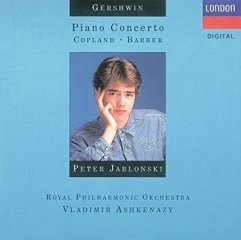Gershwin Piano Concerto in F; Copland El Salon Mexico, Piano Blues No 3; Barber Ballade (1991)
Gershwin Piano Concerto in F; Copland El Salon Mexico, Piano Blues No 3; Barber Ballade (1991)

Gershwin - Piano Concerto In F 1. Allegro 12:56 2. Adagio 13:20 3. Allegro Agitato 6:46 4. Copland - El Salón Mexicó (Transcribed Leonard Bernstein) 10:46 5. Copland - Piano Blues No.3 (For William Kapell) 3:15 6. Barber - Ballade, Op.46 6:37 Gershwin – 3 Preludes For Piano Solo 7. 1. Allegro Ben Ritmato E Deciso 1:30 8. 2. Andante Con Moto E Poco Rubato 3:50 9. 3. Allegro Ben Ritmato E Deciso 1:12 Peter Jablonski – piano Royal Philharmonic Orchestra Vladimir Ashkenazy – conductor
From the time of Copland's first visit to Mexico City in1932, when his friend Carlos Chávez took him to the colorful nightclub called "El Salón México," Copland wanted to compose a piece about the unusual dance hall. He said, "I was attracted by the spirit of the place and by the Mexican people. Using Mexican melodies seemed appropriate. My purpose was not merely to quote literally, but to heighten without in any way falsifying the natural simplicity of Mexican tunes." Much to Copland's surprise and delight, El Salón México was welcomed warmly in Mexico and has consistently been one of his most performed pieces. He said, "Never in my wildest dreams did I expect this kind of acceptance for the piece!" ---Vivian Perlis, boosey.com
Aaron Copland's Four Piano Blues is a collection of four short works for solo Piano which intergrates different elements of various jazz and blues idioms. Though the pieces were published together as a set in 1949, the piece were written at separate times, and each dedicated to different friends of Copland. ---musicroom.com
This was Barber's last completed piano work. In 1977, the organizers of the Van Cliburn competition asked him to provide a 'morceau de concourse' for that year's competition. He produced the seven-and-a-half-minute piece after almost a year. The work comprises three sections in lied form, the last section being a repeat of the first. Section A opens with a descending phrase which is repeated with changes. An ascending rush leads to the most recognizable theme, made up of three motives which depart from one chord and finally return to the same. The descending phrase leads the music to a gradual desintegration. Section B starts violently, and gets even more complex and stormy. A hint at the main theme of A leads to a tense pause, which is followed by the reprise of A. ---Hector Bellman, allmusic.com
download (mp3 @320 kbs):
yandex 4shared mega mediafire uloz.to cloudmailru ge.tt








